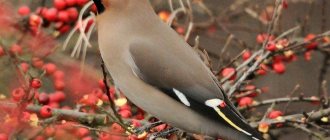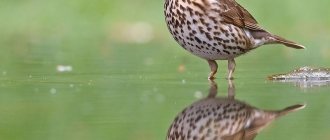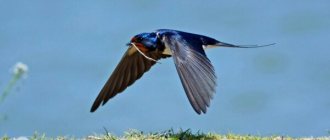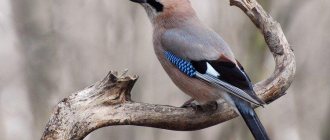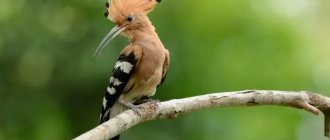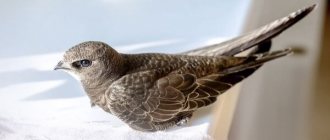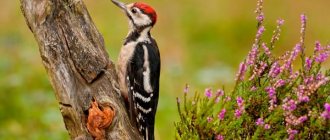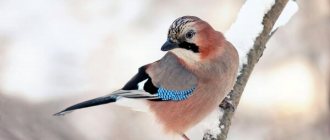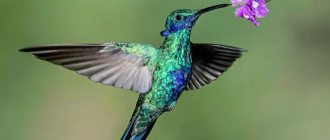Feather color as information
Why are birds so bright? For whom did the robin color its breast so brightly? After all, this is how she unmasks the seed. Any predator, even with poor eyesight, will see a red speck jumping in the bushes. And here not only males, but also females have a bright spot.
In birds, vision is the main sense organ from which they receive information. Of all the many visual signals, birds, first of all, need to recognize the enemy, food, chicks and individuals of their own species, especially if it is a representative of the opposite sex.
Each individual has identification marks by which it can be classified as “one of our own”. This is extremely important for any kind of communication. A bright spot on a robin serves as an identification mark of belonging to:
- to this species;
- a certain gender;
- stage of puberty.
Differences in the brightness and configuration of the crimson spots provide the individual with information that there is a rival or reproductive partner in front of it. Since these birds are insectivores, their coloring cannot serve as a recognition of potential prey. But red-breasted birds for the chicks are a sign that their own bird has flown to them, which can feed them. It is at this moment that you need to scream and open your beak wide. If something flies up without a bright spot, then you need to freeze silently, merging with the nest.
Thus, the bright coloring of a small bird carries some risk of unmasking, but it allows you to quickly obtain the necessary information, recognizing your partner in the hard work of feeding the successors of its kind.
Natural enemies of robins
Photo: Wintering Robin Robin
These small birds have a lot of enemies in nature. These include:
- hawks;
- falcons;
- martens;
- cats;
- stoats;
- foxes;
- caresses;
- ferrets.
These predators love to destroy the nests of robins in order to feast on eggs or young chicks. This is why there is such a high mortality rate among young birds. Adults, of course, try to protect their nests, but they also run the risk of being eaten. Therefore, in extreme cases, they can simply fly away, thereby saving their own lives. If the bird lives near people, and it is accustomed to being fed. In case of danger, she can turn to a person. These birds are easily tamed by feeding. Capable of living in captivity.
Interesting fact: Robins cannot tolerate sudden changes in temperature and cold and often die from bad weather conditions.
Gallery: robin bird (25 photos)
general description
The robin is a thrush, and its closest relatives are nightingales. But outwardly these birds are completely different, at least due to the location of the body relative to the paws.
Appearance
Robins are very tiny - up to 22 g in weight and 14 cm in length. They have a black short and sharp beak, black beady eyes and long legs with equally long claws for clinging to branches. The back of the bird is gray-green with a brown tint, the belly is white or gray, but the chest and part of the head are bright red.
Interestingly, the plumage of robins from the southern regions is usually brighter. In addition, the young chicks are different - they are motley, with brown spots, but completely inconspicuous against the background of branches and foliage. This camouflage protects them from danger.
Photo: photocentra.ru
Male and female robins: differences
Male and female robins differ little from each other. The only difference is that the color of the female is a little paler and there is not such a clear separation between the head and back. But it's hard to notice until you sit two birds next to each other.
But their habits are different. Males in particular are very aggressive towards each other because robins are terrible possessors by nature. And also because there are much more females in nature than males, and they are often left without a mate.
Photo: komotoz.ru
Singing
The robin is a songbird, and its song is very melodic and harmonious. This is a set of high-pitched whistling sounds that are intertwined into a complex melody. Robins sing mainly after sunset, and during the mating season only males sing, and the rest of the time - males and females.
Photo: smallivingworld.ru
How long do robins live?
On average, robins live about 5 years, but cases up to 12 are known. Moreover, their life cycle is slightly different from the usual. For example, robins breed twice a year.
Photo: nat-geo.ru
Nesting behavior
The robin's nest is built on the ground, in natural depressions, and also in low bushes. The building materials are leaves, fluff and blades of grass. The eggs are also colored to match the color of dry grass. They are slightly pink, sometimes yellow, almost white, with red spots.
Bright coloring for a small bird carries some risk of unmasking, but it allows you to quickly obtain the necessary information by recognizing its partner
Robins are migratory birds. Despite their small stature and adherence to a diet of insects, they arrive early and fly away late. After wintering, they appear in our area in March, when there is still snow and there are sub-zero temperatures.
The males arrive first. Their task is to defend the territory from the penetration of other males of this species, to protect an old nest or to build a new one. The females arrive later, when the males have already sorted out their nests and territories. At this time, the years of the first insects begin. So by May you can already lay eggs.
Usually there are 5-8 eggs in one clutch. Incubation time lasts about 2 weeks. The chicks are born into the world weak, naked, almost black. In the first few days, one of the parents constantly warms them with their body.
The chicks stay in the parent's nest for no more than half a month. After this they leave the nest. Such early departure is due to the fact that under favorable conditions the robins have time to lay eggs again.
When the chicks leave the nest, they do not yet know how to fly. For this reason, they are colored slightly differently than their parents. They need to blend in with their environment until they learn to fly well, which is why they are painted in the colors of dry leaves and dark grass.
All robins have very good parental instincts. Not only do they manage to raise 2 generations of chicks over the summer, they often begin to feed orphaned robins. Cuckoos use this. They throw their giant egg into the little birds' nest. Robins, in their desire to feed all the suffering, do not notice the insidious substitution.
It is thanks to the strong instinct and irrepressible energy of robins that small birds always sing in the forests and their huge parasites crow.
What does the robin eat?
Photo: Robin in winter
The diet of this little bird is based on various insects. Robin prefers:
- Zhukov;
- spiders and other arthropods;
- midges and flies;
- worms, caterpillars;
- snails;
- small butterflies.
Depending on where the bird lives, its diet can vary greatly. The denser the forest where the bird lives and the more vegetation, the more food the robin will find. The bird hunts by moving from branch to branch or picking up food on the ground. Hunt both during the day and at night. It can often catch small midges and beetles during flight. In the summer, he likes to eat currants, elderberries, and rowan berries. In autumn and winter, when food becomes scarce, robins go in search of various seeds and peck at the fruits remaining on tree branches. It can fly up to bodies of water and find food there. The robin is not at all afraid of water. Robins remaining to spend the winter find food in feeders. If the bird is fed, it can settle next to the house and can live like that all winter. In addition, if a robin takes up residence in the garden, it will only benefit the garden as it will exterminate harmful insects.
Interesting fact: It is difficult for a robin to feed from a feeder; the bird is used to clinging to tree branches with its paws, so if you need to feed a robin, it is better to pour the food on the ground.
Habitats and feeding preferences
This bird prefers to live in the forest. However, she does not like the dense taiga, but mixed forests with dense undergrowth, clearings, edges and forest windows. The robin especially loves thickets near bodies of water - in floodplains, on the shores of lakes.
The robin can live next to a person if he does not interfere with it and creates thickets with trees of different heights, bushes and grass. True, humans are accompanied by cats, which turn into the main enemies of these birds.
Despite the fact that the robin is considered an insectivorous bird, in spring and autumn, when animal food is in short supply, it feeds on seeds and berries. At the height of summer, when the chicks are squeaking in the nest, the red-breasted father and mother tirelessly hunt for caterpillars, spiders, worms and other protein foods.
In nature, the main enemies of robins, apart from humans and cats, are representatives of the mustelidae family (sable, weasel, mink, marten, ferret). Badgers, foxes, wolves and, of course, domestic dogs love to destroy robins' nests. From the bird world, all small birds of prey are interested in adult robins and their chicks, including shrikes, which steal chicks from nests, eat them or store them, attaching them to twigs or thorns.
The entire life of a robin, like every earthly creature, is devoted to performing 2 functions: to be someone’s food supply and to limit the number of someone who is its food supply. However, she has one more function - to delight a person with her voice and bright outfit.
Types of waxwings
There are only a few main types, which are also quite similar. According to different classifications - from 3 to 8, so this is not the most extensive family. We have chosen the most interesting varieties!
Common waxwing
The brightest, most numerous representative of the family with the most extensive geography. The easiest way to identify it is by the same yellow border on the wings and tail.
Photo: funart.pro
Black waxwing
Males are painted blue-black with metallic highlights, but females are gray. This is just one species with a pronounced difference between them.
Photo: vashurok.ru
Amur waxwing
A small representative of the family with a body up to 16 cm. It differs from the ordinary one only by a red stripe instead of yellow and a bluish tint to the undertail.
Photo: krasivosti.pro
Gray silk waxwing
A tropical resident with inconspicuous gray plumage and a bright yellow belly. Its deliberate unsightliness is what makes it stand out among the colorful exotic birds.
Photo: clasbio.ru
American waxwing
It is also called cedar, after its favorite place of residence. In addition to North America, the species is found in Great Britain and Scandinavia. The birds have a yellowish belly and a brown back.
Photo: mentalfloss.com
Long-tailed waxwing
The main feature of this species is its long tail, which is easy to guess. The gray plumage gradually fades to yellow on the head, belly and tail.
Photo: orientaltravel.ru
Jay (50 photos): description of the bird, what it eats and where it lives

